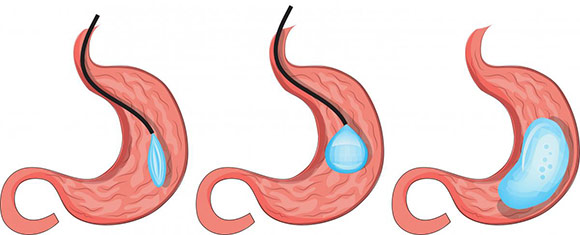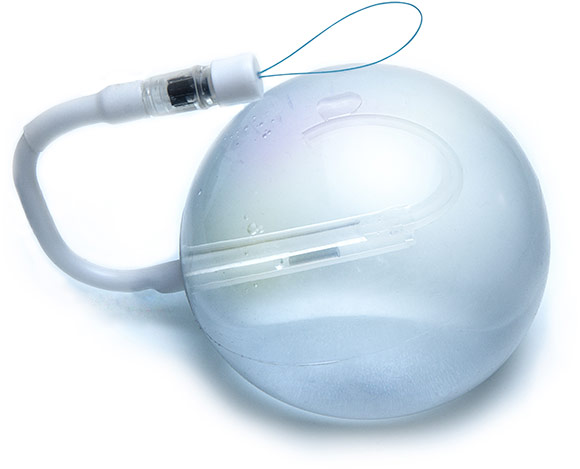What is Gastric Balloon?
A gastric balloon, also known as an intragastric balloon, is a type of weight-loss treatment that doesn’t involve surgery. It’s a temporary and less invasive procedure than bariatric surgeries, such as gastric bypass or gastric sleeve.
- The balloon is placed into the stomach through the mouth, using a minimally invasive endoscopic procedure while the patient is sedated.
- Once in the stomach, the balloon is then filled with a saline solution, which partially fills the stomach, creating a feeling of fullness and limiting food intake.
- The balloon is left in the stomach typically for about six months, during which time the patient may lose weight.
- After the intended period, the balloon is then deflated and removed via another endoscopic procedure.
- While the balloon is in place, the patient also typically follows a diet and exercise program to assist with weight loss and maintain it once the balloon is removed.

Who is the gastric balloon suitable for?
The gastric balloon procedure is typically used for individuals who have not had success with traditional methods of weight loss like diet and exercise or medication.
As per the guidelines from 2021, it’s often suitable for those with a Body Mass Index (BMI) between 30 and 40, which classifies them as obese. However, the exact requirements may vary depending on specific medical guidelines, and local regulatory standards.
It’s particularly beneficial for individuals who need to lose weight before undergoing a surgical procedure, to reduce the risk associated with anesthesia and the surgery itself.

However, a gastric balloon is not suitable for everyone. It’s generally not recommended for individuals who:
- Have previously had gastrointestinal or bariatric surgery
- Have certain conditions such as hiatal hernia or gastric ulcers
- Have an inflammatory disease of the gastrointestinal tract, such as Crohn’s disease or ulcerative colitis
- Are pregnant or planning to become pregnant
Every patient’s situation is unique, so it’s important to have a thorough consultation with a healthcare professional before deciding on any weight loss procedure. The doctor will consider the patient’s overall health, weight, diet and exercise habits, and psychological status when making a recommendation.
It’s also important to note that a gastric balloon is not a long-term solution for weight loss. It should be used in conjunction with a long-term plan for a healthier lifestyle, including diet changes and regular exercise. The procedure is meant to kickstart weight loss, but maintaining the weight loss requires long-term lifestyle changes.
Gastric Balloon Procedure
The gastric balloon procedure is a non-surgical weight loss treatment.
Preparation
Before the procedure, patients typically undergo a thorough medical examination to ensure they are suitable candidates. This often includes blood tests, an evaluation of medical history, and possibly an endoscopy to inspect the stomach.
Placement
The procedure itself usually takes around 20-30 minutes and can be performed on an outpatient basis, meaning that you can usually go home the same day. The patient is sedated, and the deflated gastric balloon is inserted through the mouth and esophagus into the stomach with the help of an endoscope – a thin, flexible tube with a light and camera.

Inflation
Once the balloon is in place in the stomach, it’s filled with a saline solution or air, depending on the type of balloon used. This is done through a small filling tube attached to the balloon. Once filled, the balloon floats freely in the stomach.
Removal of equipment
The filling tube is then detached and removed through the mouth. The balloon stays in the stomach.
Post-procedure
After the procedure, the balloon gives a sense of fullness, helping the patient to eat less and lose weight. The patient should follow a diet and exercise program during this period to optimize weight loss.
Removal
After a certain period (usually six months), the balloon is then deflated and removed using a similar endoscopic procedure. Some newer balloon models may not require endoscopy for removal, depending on the specific product and local regulations.
Throughout the treatment period, patients should have regular check-ups with their healthcare provider to monitor their progress and manage any side effects. Remember, this procedure is meant to assist with weight loss as part of a larger lifestyle modification program.
The specifics of the procedure can vary based on the type of gastric balloon used, the specific practices of the clinic or hospital, and the individual patient’s needs.
After The Gastric Balloon Procedure
After the gastric balloon procedure, patients generally need to follow specific post-procedure guidelines to optimize weight loss and ensure safety. Here’s a general outline:
Recovery
Immediately after the procedure, patients may experience some nausea, vomiting, or abdominal discomfort as the body adjusts to the balloon. These side effects typically subside after a few days to a week.
Diet
In the first few days after the procedure, patients usually start on a liquid diet before gradually introducing soft foods and then moving onto solid foods over a period of one to two weeks. It’s important to follow the dietary guidelines provided by the healthcare provider.
Lifestyle changes
Patients should engage in a structured diet and exercise program to support weight loss while the balloon is in place. This is crucial for both losing weight and maintaining weight loss after the balloon is removed.
Regular check-ups
Regular follow-up appointments will be scheduled with healthcare providers to monitor progress, manage side effects, and provide diet and exercise guidance.
Balloon removal
After approximately six months (the period may vary), the balloon is deflated and removed through an endoscopic procedure. The removal process is similar to the placement procedure.
Continued support
After the balloon is removed, continued follow-up appointments and support are generally provided to help maintain weight loss and a healthy lifestyle.
It’s important to remember that the gastric balloon is a tool to help with weight loss, not a cure for obesity. It should be used as part of a broader weight management program, which includes diet modification, regular physical activity, and behavior changes.
These are general guidelines; the specifics can vary based on individual healthcare providers and patient needs. Therefore, it’s essential to have detailed discussions with a healthcare provider to understand what to expect after the procedure.

Weight Loss
The average gastric balloon patient loses a moderate amount of weight very quickly after the procedure:
- Month 3: Approximately 15% of excess weight
- Month 6: Approximately 30% of excess weight
- Actual weight loss could be higher or lower.
The most popular types of balloon must be removed after 6 months, so long-term weight loss depends entirely on the patient’s diet and lifestyle choices. In other words, gastric balloon should not be viewed as a “long-term fix.”
Gastric Balloon Removal Procedure
The gastric balloon removal procedure takes about 20 to 30 minutes and is very similar to the insertion procedure for the Orbera, ReShape, and Spatz systems (Obalon uses swallowed pills for balloon insertion):
- No food 24 to 48 hours before surgery (depends on surgeon)
- No food or drink 12 hours before surgery
- Scope and instrument passed through mouth to deflate balloon(s)
- Balloon is removed through the mouth
- Return home the same day

Risks of the gastric balloon
As with any medical procedure, the gastric balloon has potential risks and side effects. These can vary based on individual health conditions, the type of balloon used, and the specific practices of the clinic or hospital. Here are some possible risks and side effects to consider:
- Gastrointestinal symptoms: Nausea, vomiting, and abdominal discomfort are common in the first few days after the balloon is placed as the body adjusts to the balloon. These symptoms generally subside after a few days to a week.
- Gastric ulcer: There’s a small risk of developing gastric ulcers due to the presence of the balloon.
- Balloon deflation: In rare cases, the balloon may deflate. If the deflated balloon passes into the small intestine, it can cause a blockage that might require emergency surgery.
- Gastric perforation: Though extremely rare, there is a risk of gastric perforation (a hole in the stomach wall) either during the placement or removal of the balloon or as a result of the balloon causing damage to the stomach wall.
- Poor tolerance: Some people may not tolerate the balloon well, experiencing ongoing nausea, vomiting, or abdominal pain. In such cases, the balloon may need to be removed early.
- Insufficient weight loss or weight regain: Some individuals may not lose significant weight with the gastric balloon, especially if they don’t make necessary dietary and lifestyle changes. Additionally, there’s a risk of regaining weight after the balloon is removed if ongoing lifestyle modifications are not adhered to.
These potential risks underscore the importance of having the procedure performed by an experienced medical team and in a setting where any complications can be promptly addressed. Patients should discuss the potential risks and benefits with their healthcare provider before deciding to proceed with a gastric balloon procedure. It’s also crucial to understand that the gastric balloon should be part of a comprehensive weight loss program, including diet, exercise, and behavior changes, to increase the chance of long-term success.
Gastric Balloon in Turkey
Turkey has become a popular destination for many types of medical procedures, including the gastric balloon procedure. The advantages of having a gastric balloon procedure in Turkey can include:
- Cost: Medical procedures in Turkey, including the gastric balloon, are often much less expensive than in countries such as the US or the UK. This can make procedures more accessible for individuals who might not otherwise be able to afford them.
- Quality of Care: Many Turkish hospitals, especially those catering to medical tourists, offer high-quality medical care. They are staffed with skilled and experienced doctors, many of whom have trained internationally.
- Accreditation: Several Turkish hospitals are accredited by internationally recognized bodies such as the Joint Commission International (JCI), indicating they meet high standards of care.
- State-of-the-art Facilities: Many Turkish hospitals and clinics that cater to medical tourists have state-of-the-art facilities and use the latest medical technologies.
- Hospitality and Aftercare: Turkey is known for its hospitality, and this extends to medical care. Comprehensive aftercare and recovery services are often part of the package, and some providers may also offer services like accommodation and transportation as part of the package.
- Tourism Opportunities: For those who are fit to travel before or after their procedure, Turkey offers a wealth of cultural, historical, and recreational experiences.
Gastric Balloon Alternatives
- Gastric sleeve surgery: This is a minimally invasive weight loss surgery that involves removing a large portion of the stomach. This makes the stomach smaller, which helps people eat less and lose weight.
- Swallowable gastric balloon: This is a non-surgical weight loss procedure that involves placing a balloon in the stomach. The balloon takes up space in the stomach and makes the patient feel fuller sooner. This can help people eat less and lose weight.
- Gastric bypass surgery: This is a more invasive weight loss surgery that involves rerouting the digestive system. This makes it harder for the body to absorb calories, which helps people lose weight.
- Mini gastric bypass surgery: This is a less invasive version of gastric bypass surgery. It involves rerouting the digestive system in a similar way, but it is not as extensive as gastric bypass surgery.
